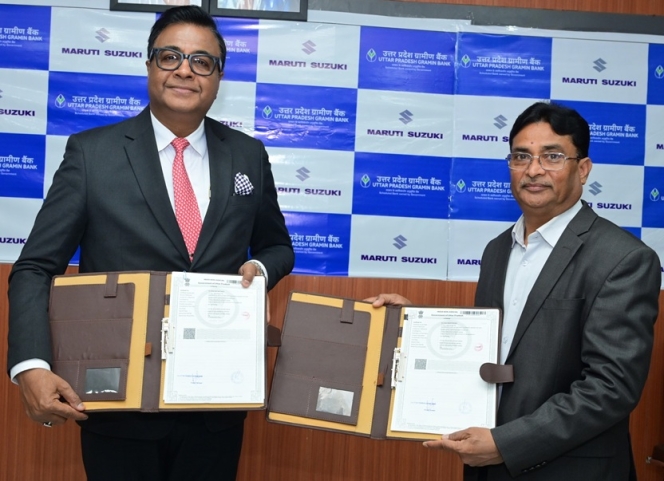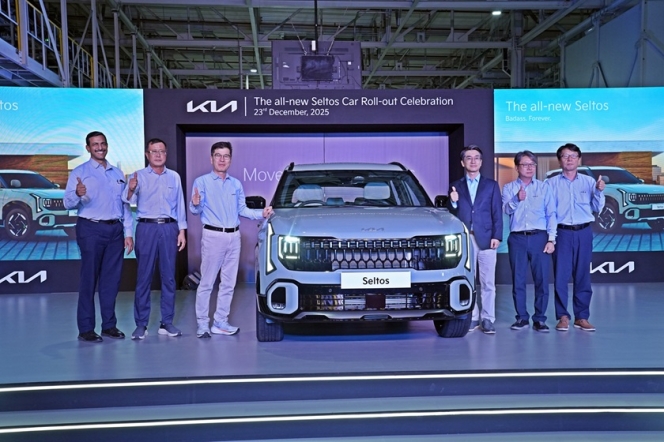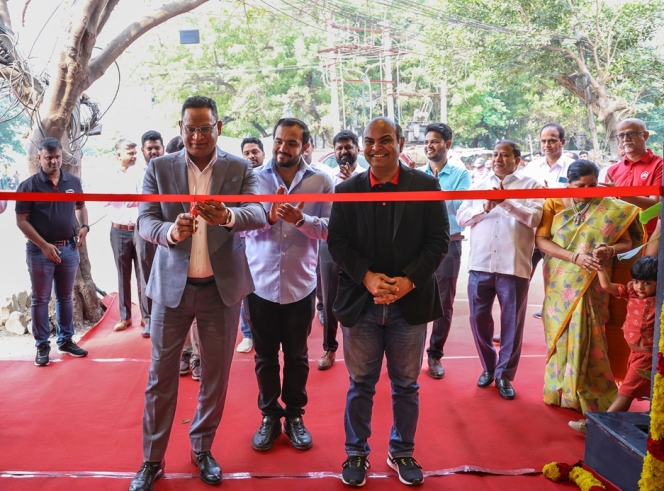
Mercedes-Benz is gearing up to make their presence felt in the entry-level luxury segment with the all-new A-Class Limousine. The new sedan replaces the erstwhile CLA though it’s not like a replacement as the CLA was a coupe, and the new A-Class Limousine is a traditional three-box sedan. One may ask, when SUVs are in high demand in both India and globally, why take out a sedan? Mercedes-Benz has the stats to back their logic as the sedan range constituted 53 percent of their sales last year. This new vehicle is available in three variants — petrol, diesel and the all-powerful AMG. We drove the A 200 petrol version. So, let’s find out if it is a total package.
Exteriors
The A-Class sedan makes quite a style statement with a star-studded front grille with a thick chrome line running across it. The angular shaped LED headlights, and L-shaped daytime running lamps (DRLs), the pronounced character lines on the bonnet and chunky lower front bumper with mock air dams all make the A-Class sedan look contemporary and muscular.
Moving on to the side profile, the A-Class Limousine has prominent lines running across the shoulder area and another line on the lower part of the doors. As it’s not a coupe, the sedan gets a taller roofline. It may look more or less identical to its hatchback sibling till the B-pillar, and from there till the boot, it looks like a ‘baby’ C-Class, which is a good thing as this sedan looks proportionate and regal.
Coming to the rear, it has a clean design. One may find it a bit too simple, but the edgy looking LED taillights, and the trapezoid twin exhaust pipes in chrome make the rear styling more appealing. In terms of practicality, the petrol version has a boot capacity of 405-litres and while the diesel gets 395-litres. The loading bay is wide and accessible, making it easy to plonk a full-sized stroller. The boot is deep enough to store two full-sized suitcases or strollers.
 Interiors
Interiors
Step inside the cabin, and the design language is on the lines of the S-Class, but the icing on the cake is that they have managed to create a rich and luxurious ambience. The beautifully crafted three-layer dashboard uses premium leather, wooden and metal materials. The centre of attraction has to be the two 10.25-inch screens — one is the touchscreen infotainment system, and the other is the all-digital instrument cluster. Both the screens’ graphics are outstanding, while the touchscreen is responsive. The multi-media system can also be controlled by the haptic pad on the central console. Unlike the previous generation, it doesn’t have any lag and is intuitive. There are also touch buttons on the steering wheel to browse through the media player and change the digital instrument cluster settings.
Mercedes has crafted five air vents inspired by a jet turbine. They look exquisite, to say the least. The A-Class Limousine is equipped with class-leading features like the smart artificial intelligence voice command or as the manufacturer calls it MBUX (Mercedes-Benz User Experience). The AI is as receptive as Apple’s Siri and Google Assistant and it understands the Indian accent. With a simple command like ‘Hey Mercedes! I’m feeling hot, it will change the cabin temperature according to your comfort level. It also comes with connected-car technology, which is integrated into both Amazon’s Alexa and Google Home and allows you to unlock the door or switch on the air conditioner from the comforts of your home. Apart from this, it comes with the usual features like a sunroof, wireless phone charger, Apple CarPlay, Android Auto, 64 ambient light options, 2 zone climate control and five USB Type-C ports.
 There’s a very good chance that an A-Class sedan owner might end up spending a lot of time behind the wheel rather than being chauffeured around. Keeping that in mind, the front seats are electrically adjustable and come with a memory function allowing you to save your seating position. The seats offer good lumbar support and are comfortable, especially on long drives. With 2,729mm of the wheelbase, the A-Class Limousine is the longest sedan in its segment, and this translates into a spacious cabin, especially for the rear passengers. The angular position of the backrest provides good support though the seat squab lacks under-thigh support. The Achilles heel in this segment has been the legroom for rear passengers, but Mercedes-Benz has managed to iron out this problem as there’s plenty of it. As a matter of fact, the cabin also has a roomy headroom. It’s safe enough to say that the A-Class sedan’s cabin is a comfortable place to be in.
There’s a very good chance that an A-Class sedan owner might end up spending a lot of time behind the wheel rather than being chauffeured around. Keeping that in mind, the front seats are electrically adjustable and come with a memory function allowing you to save your seating position. The seats offer good lumbar support and are comfortable, especially on long drives. With 2,729mm of the wheelbase, the A-Class Limousine is the longest sedan in its segment, and this translates into a spacious cabin, especially for the rear passengers. The angular position of the backrest provides good support though the seat squab lacks under-thigh support. The Achilles heel in this segment has been the legroom for rear passengers, but Mercedes-Benz has managed to iron out this problem as there’s plenty of it. As a matter of fact, the cabin also has a roomy headroom. It’s safe enough to say that the A-Class sedan’s cabin is a comfortable place to be in.
Engine
The A-Class Limousine gets a 1.3-litre turbocharged petrol motor under the hood. The engine’s capacity might not wow you, but it churns out 161bhp and 250Nm of torque. It does 0-100 km in 8.3 seconds, which is fast. According to ARAI, the A-Class sedan returns a fuel economy of 17.5kmpl, making it the best in its class. This front-wheel-drive car is mated to a 7-speed dual-clutch automatic transmission. Step on the gas, and the car responds in a linear manner. However, the turbo lag can be felt; the best way to negate that is to downshift with paddle shifters’ help on the back of the steering wheel. For tackling bumper-to-bumper traffic, automatic transmission’s ensures spot-on gear shift ensuring there’s ample power available. It comes in four driving modes — Eco, Comfort, Sport and Individual. Eco, as the name suggests, is all about getting the best fuel economy. While Comfort balances power, comfort and mileage. Sport, on the other hand, is where the engine is more responsive, the rev needle holds on a bit longer and goes past the 6,000 rpm mark, the steering wheel becomes a bit heavier for better stability at high speeds, and even the suspension is firm for better handling. Also, on this mode, the turbo lag reduces significantly. The ‘Individual’ mode enables you to customise it according to your preference. The engine is fairly refined and offers optimal performance in the mid-range power band.
Signing Off
The A-Class Limousine does manage to tick a lot of boxes like styling, practicality, performance and technology. The ride quality is ideal for Indian road conditions as it carpets, ditches and potholes easily thanks to a soft suspension set up. It isn’t meant for attacking corners or taking high speed turns, but it remains stable, although the body roll can be felt. Another feather in Mercedes-Benz’s cap is that the A-Class sedan comes with the country’s first-ever eight-year warranty with unlimited kilometres. If you are looking to enter the luxury segment, then the A-Class Limousine is a car you can bank on. It will take on the BMW 2 Series Gran Coupe and the upcoming Audi A3. (MT)
Citroen India Delivers 51 C3 CNG Vehicles To Luthra Group
- By MT Bureau
- December 24, 2025
Citroen India, in partnership with its dealership La Maison Nanavati, has completed the handover of 51 Citroen C3 CNG vehicles to the Luthra Group. The ceremony took place at the Luthra Group’s headquarters in Surat.
The delivery is part of Citroen's strategy to expand its presence in tier-II and tier-III markets by providing mobility solutions to businesses and individuals.
The Citroen C3 CNG is designed for high-usage environments and daily commutes. The model includes several features tailored for the Indian market, integration of a factory-fitted CNG kit to manage running costs. A suspension system tuned specifically for local road conditions. Provisions for cabin space and air-conditioning systems designed for high-ambient temperatures.
The handover to Luthra Group represents the brand's focus on cost-efficient transportation. By targeting the regional business sector, Citroen India aims to strengthen its footprint in Gujarat and the broader Indian mobility market.
The C3 CNG is positioned as a solution for users requiring reliability and low operating expenses without compromising on ride comfort.
Maruti Suzuki India Partners Uttar Pradesh Gramin Bank For Retail Financing
- By MT Bureau
- December 24, 2025

Maruti Suzuki India has signed a Memorandum of Understanding (MoU) with Uttar Pradesh Gramin Bank, a regional rural bank, for vehicle retail financing partnership on new cars, pre-owned vehicles and commercial vehicles.
This collaboration marks the 50th retail finance partner for Maruti Suzuki India. The partnership is intended to use the bank’s network to provide credit options to a range of customer profiles, particularly in rural and semi-urban regions.
The partnership aims to increase the accessibility of Maruti Suzuki products through, tailored finance schemes designed for rural and regional customers.
Partho Banerjee, Senior Executive Officer, Marketing & Sales, Maruti Suzuki India, said, “Our partnership with Uttar Pradesh Gramin Bank marks a significant milestone as we onboard our 50th retail finance partner. This reinforces our commitment to making car ownership simpler and more affordable for customers across India. By expanding our reach through this strategic alliance, we aim to empower buyers with competitive, customer-friendly financing solutions that enhance the overall purchase experience. We remain focused on delivering seamless, tailored finance options, and this collaboration strengthens our vision of providing the Joy of Mobility to aspiring Indian consumers.”
Yadav S. Thakur, Chairman, Uttar Pradesh Gramin Bank, said, “At Uttar Pradesh Gramin Bank, empowering customer aspirations is at the heart of everything we do. Our partnership with Maruti Suzuki, a leader in the automotive industry, is a strategic step towards enhancing our service offerings and delivering greater value to our customers. This collaboration aligns with our 'Customer-First' mission, enabling us to provide accessible and affordable vehicle financing solutions. We look forward to helping more individuals and families across the country realise their dream of owning a Maruti Suzuki vehicle.”
Kia India Commences Production Of New Seltos In Anantapur
- By MT Bureau
- December 23, 2025

Kia India has started production of the latest generation Seltos at its manufacturing facility in Anantapur. The company has confirmed that prices for the mid-SUV will be announced on 2 January 2026.
The Anantapur plant, established in 2019, serves as a hub for both the Indian domestic market and international exports. The facility uses automation and a local workforce to manufacture the Seltos, which was the first model produced by the company in India.
The new model is built on Kia’s K3 platform, which has been engineered to increase structural rigidity and improve suspension damping. The vehicle has grown in size compared to its predecessor to increase cabin space and stability. It has 4,460 mm of length, 1,830 mm of width and a wheelbase of 2,690 mm.
The exterior design follows the ‘Opposites United’ philosophy, featuring a ‘Digital Tiger Face,’ LED projection headlamps, and alloy wheels with neon brake callipers.
The vehicle integrates several digital interfaces and driver assistance systems. It features an upgraded Kia Connect 2.0 suite with over-the-air (OTA) software updates and a proximity unlock function.
In terms of safety, it gets 24 features as standard, while ADAS Level 2 offers 21 autonomous features to assist the driver. The Kia Seltos SUV comes with three engine options – 1.5-litre Petrol producing 115 PS of power and 144 Nm of torque, 1.5 T-GDI Petrol producing 160 PS of power and 253 Nm of torque and a 1.5-litre diesel engine producing 116 PS of power and 250 Nm of torque.
Transmission choices include a 6-speed manual (6MT), intelligent manual (6iMT), IVT, 7-speed dual-clutch (7DCT) and a 6-speed automatic (6AT). The model will be sold in four trims – HTE, HTK, HTX and GTX – with additional option variants and an X-Line styling pack.
Gwanggu Lee, Managing Director & CEO, Kia India, said, “The roll-out of the All-New Kia Seltos marks a proud milestone for Kia India. Seltos has long set benchmarks in the mid-SUV segment, and this new generation represents a bigger, bolder, and more progressive evolution shaped by insights from Indian customers. With production now underway at our Anantapur facility, our teams are fully geared to ensure customers can take delivery of their all-new Seltos without long waiting periods. We are confident the all-new Seltos will once again redefine expectations in the segment and strengthen Kia’s leadership in India."
“The new Seltos looks fantastic. The Anantapur team, together with our supplier partners, have done an outstanding job in delivering our customers a great looking, significantly bigger, technologically progressive and safe vehicle with impressive functionality and connectivity,” he said.
- Citroen India
- Jeep
- Stellantis
- Citroen 2.0
- Shailesh Hazela
- Kumar Priyesh
- Sree Venkata Teja Kethineni
- VTK Automobiles
Citroen India Opens 126th Outlet In Chennai Under Citroen 2.0 Strategy
- By MT Bureau
- December 23, 2025

Stellantis-owned French automotive brand Citroen India has inaugurated its 126th point of sales and service (POS&S) facility in Chennai, continuing the expansion of its network under the ‘Citroen 2.0 – Shift Into The New’ strategy.
The new 3S (Sales, Service and Spares) facility is located at Chitlapakkam, near Chrompet. It is an extension of the partnership with VTK Automobiles, which now operates five Citroen touchpoints in the city. The outlet functions as a ‘Stellantis Brand House,’ allowing customers to access both Citroen and Jeep brands within a single space.
Since the announcement of the Citroen 2.0 strategy, the brand has increased its network by 48.6 percent. Over the last six months, the company added 43 points of sale through its network expansion programmes. Citroen expects to reach a total of 135 outlets by the end of the year, with further operations planned for the north, west, and east of India.
The strategy focuses on several pillars – deepening the domestic supply chain for India-centric products. Expanding the dealer footprint into Tier 2 and Tier 3 locations. Using digital tools and unified spaces for sales and aftersales services.
Shailesh Hazela, CEO and Managing Director, Stellantis India, said, “The expansion of Stellantis network further with VTK dealership in Chennai marks another important step in Citroen and Jeep India’s network growth strategy. Chennai is a key market for us, and this upgraded facility will enable us to serve our customers better with a seamless sales and ownership experience. Aligned with our Citroen 2.0 strategy, we remain committed to strengthening our dealer partnerships and building a robust, customer-centric network across the country.”
Kumar Priyesh, Director Automotive Brands, Stellantis India, said, “We have grown our network by almost 48.6 percent since we announced the Citroen 2.0 strategy and have been able to expand our operations in different parts of country: adding tier 2/3 locations while further strengthening in Metro/ Tier 1 cities. Through project Visitar, Network Expansion Program and expansion in new geographies we added over 43 POS in the last 6 months and are already in advanced stages to start additional operations in North, West and Eastern parts of the country and expected to close the year with 135 POS for Citroen.”
Sree Venkata Teja Kethineni, Dealer Principal, VTK Automobiles, said, “We’re happy to partner to this pivotal shift in automotive retail, proudly representing Jeep and Citroen. Our dual-brand strategy empowers us to deliver a truly elevated and distinctive experience – whether customers seek rugged performance or refined sophistication. With passion, professionalism and personalised care at the core, our team is committed to exceeding expectations and upholding the global standards these iconic brands represent.”
The facility includes a service centre equipped with diagnostics and digital tools. Staff members are trained across both Jeep and Citroen product lines to provide technical support and product information.






Comments (0)
ADD COMMENT